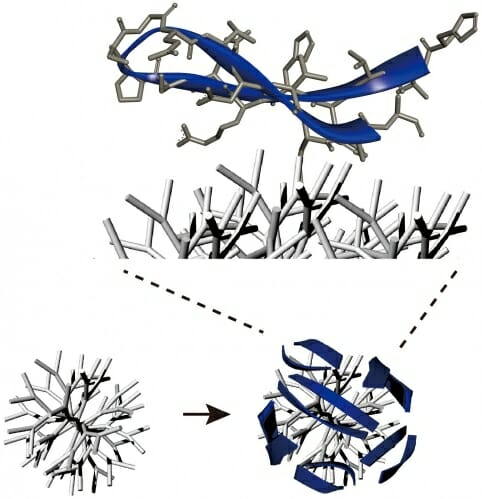Jan 30 2020
Scientists at the University of Wisconsin–Madison have created nanoparticles with the ability to trigger immune responses to cancer cells in the laboratory. Once they are also demonstrated to be effective in the body as they are in the laboratory, these nanoparticles might offer a more economical and effective way to combat cancer.
 The nanoparticles were made of sections of the T cell protein PD-1 (in blue) attached to a branched core called a dendrimer (in gray). The branches in the core of the nanoparticle allowed many chunks of the PD-1 protein to bind to the nanoparticle, increasing its effectiveness. Image Credit: Seungpyo Hong.
The nanoparticles were made of sections of the T cell protein PD-1 (in blue) attached to a branched core called a dendrimer (in gray). The branches in the core of the nanoparticle allowed many chunks of the PD-1 protein to bind to the nanoparticle, increasing its effectiveness. Image Credit: Seungpyo Hong.
When compared to the antibodies that form the basis of existing immunotherapies, which cost tens of thousands of dollars a month as drugs, the new nanoparticles are comparatively inexpensive to synthesize and easier to design.
Immunotherapy basically boosts the patient’s own immune system to fight against cancer cells better. The antibodies that are used right now are large, they’re expensive, they’re hard to engineer, and they don’t always show the highest level of efficacy either. So we wanted to explore other ways to activate the immune system.
Seungpyo Hong, Professor, School of Pharmacy, University of Wisconsin–Madison
In collaboration with colleagues from the University of Illinois at Chicago, the study led by Hong and postdoctoral associate Woo-jin Jeong was published online in the Journal of the American Chemical Society on January 2nd, 2020. This team was the first to demonstrate that nanoparticles have the ability to serve as immunotherapy agents.
Although further studies are required to perceive their effectiveness within the body, Hong has filed for a patent on the new nanoparticles and is currently testing them on animal models.
The nanoparticles were tested against lab-grown cancer strains and were found to increase the synthesis of interleukin-2 (the immune-stimulating protein) by T cells, a type of immune cell in the body, by nearly 50% compared to no treatment scenario. The effectiveness of the nanoparticles was on par with that of antibodies. They could also boost the effectiveness of doxorubicin, a chemotherapy drug, in similar tests.
In general, T cells synthesize a protein called PD-1 that serves as an off-switch for immune responses. This “checkpoint” prevents T cells from inappropriately attacking healthy cells.
Certain cancer cells tend to trick checkpoints on T cells and manage to hide from the immune system. They produce proteins named PD-L1to mimic healthy cells. These proteins attach themselves to the off-switch and allow the tumors to hide in plain view. Various immunotherapies make use of antibodies—proteins binding other proteins—against either PD-L1 or PD-1 to interrupt this connection.
The key here is if you block that binding very efficiently, you can now reactivate the T cells, so the T cells start attacking the tumor cells.
Seungpyo Hong, Professor, School of Pharmacy, University of Wisconsin–Madison
However, a single course of such antibodies, called checkpoint inhibitors, could cost more than $100,000 since it is costly and challenging to synthesize pure antibodies are difficult and. Similar to these antibodies, the nanoparticles created by the team bind the PD-L1 on cancer cells so they cannot trigger the off-switch on T cells. A different strategy was employed by Hong’s lab to realize the same effect.
Small chunks, or peptides, of the PD-1 protein were obtained and bound to branched nanoparticles. These peptides are stabilized by the nanoparticles so they can attach to PD-L1 on the cancer cells quite similar to the full PD-1 protein. Moreover, they include several branches that enable them to hold various copies of the PD-1 peptides and attach more strongly to PD-L1.
The nanoparticles, in test tubes, bound to PD-L1 as strongly as fully grown antibodies attached. A strong link between PD-L1 and the nanoparticles ensures that the cancer cells can no longer trick the T cells by employing these proteins.
It is possible to produce, in the lab, the peptides and the nanoparticles to which they bind in a simple and inexpensive way. It is also possible to easily tweak and modify both the nanoparticles and the peptides. Therefore, further studies could optimize them to function better by leveraging this early proof-of-concept study.
The bottom line is that, for the first time, we developed this peptide-nanoparticle platform for immunotherapy and found clear evidence that this system has great potential. We’re looking forward to the next step.
Seungpyo Hong, Professor, School of Pharmacy, University of Wisconsin–Madison
This study was supported, in part, by the National Science Foundation (Grant DMR-1808251) and the National Institutes of Health (Grants 1R01AR069541 and 1R21EB022374).